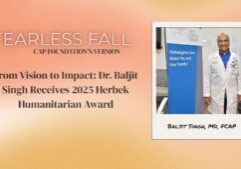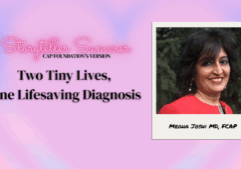See, Test & Treat Gives Patient Crucial Diagnosis, Care

Claudia Orozco knew the risks of cervical cancer before she checked in for her appointment at Montefiore Medical Center in the Bronx during their See, Test & Treat program in May of 2021. The disease upended Claudia’s family when her mother died from cervical cancer at the age of 33.
Even so, Claudia had not been to a doctor for regular exams or screenings since shortly after the birth of her 9-year-old son. Like many across the United States, a combination of lack of health insurance and high costs of care made her think twice before making appointments.
“A lot of the time, I just avoid going to the hospital because I don’t have health insurance and it’s very expensive,” Claudia said. “It’s really, really expensive to get medical care in New York, so unless you have an emergency, it’s best to stay away.”
That was until she saw a Facebook post and a flyer in the community about the upcoming See, Test & Treat program, led by pathologists Mark Suhrland, MD, FCAP, and Michael Prystowsky, MD, PhD, FCAP, which provides free cervical cancer and breast cancer screenings, health information, and other care.
Claudia explained, “So when I saw they were going to do different things, different screenings and that it was free, that was why I said to myself, ‘I have to go.’”
A Crucial Diagnosis
Claudia is glad she sought care when she did. The pathologist-led laboratory team quickly processed her Pap test, which screens for cervical cancer or cell changes that may lead to cervical cancer. They discovered a concerning abnormality.
Talitha L. Bruney, MD, is a physician in obstetrics and gynecology at Montefiore who worked with pathologists at the program and provided Claudia’s follow-up care. Dr. Bruney has volunteered with See, Test & Treat since 2015.
She explained that the abnormal Pap test showed high-grade features, which can be an indication of abnormal changes on the cervix and require a colposcopy to provide a more detailed inspection. From there, doctors recommended a biopsy, which showed high-grade, pre-cancerous abnormalities.
Dr. Bruney stressed that the abnormalities in this case were not yet cancerous, and the patient elected to have a loop electrode excisional procedure to remove abnormal parts of the cervix. Claudia will need to continue regular screenings to monitor and ensure the condition does not progress.
‘Gratifying’ Care
Claudia said that while the outcome was concerning, she was relieved it was not more serious.
“I felt good about it because they really explained each test well and the reasoning behind them to clear up any of my concerns,” she said.
Claudia further elaborated on her feelings: “At first, I was a little nervous when they did the first one because they told me it could be cancer. And I have my family history with cancer and it’s something that scares me. But I definitely feel better now having a clear answer.”
The relief she felt from her diagnosis, care, and follow-up treatment was not all. Claudia found the whole experience to be welcoming and comforting for her and her family.
Claudia explained that she went to the See, Test & Treat program with her two children, one of whom, her son, has autism.
“So, it’s hard for him to be in a place and be calm. But the people who were in the lobby and explaining the cells and everything, they took time not only to explain everything to me, but also to make sure … he didn’t get upset,” she said. “And that was so amazing to me because, sometimes, you just avoid going certain places because it’s not easy for my son to stay in one spot.”
Not only that, but Claudia was able to easily speak in her native Spanish with her physician so she could feel comfortable and properly understand her diagnosis and treatment without having to go through an interpreter.
She said, “Really the difference is night and day. Because sometimes you have a lot of questions and at times they give you an interpreter, but it’s not the same as seeing the person’s face and telling them, ‘I have been feeling like this, this is going on,’ and it’s so much more comfortable.”
Continuing Care
Free care in a respectful and welcoming setting is at the heart of the See, Test & Treat program. When patients have a good experience, they are more likely to return to their local health networks for regular health care. Dr. Suhrland, a lead pathologist for the Montefiore program, knows what patients like Claudia are up against and how important it is to bring them into the health care fold.
“Claudia’s story exemplifies the mission of See, Test & Treat: to screen an underserved population, educate, and engage patients into the health care system,” Dr. Suhrland said. “The barriers to access that were involved—cost, apprehension, language, and childcare—are but a few of the barriers that all See, Test & Treat programs seek to alleviate.”
Said S. Saab, MD, an obstetrician-gynecologist at Montefiore, also weighed in on the program: “This is a wonderful opportunity to make health care accessible to our community, regardless of background and immigration status. Often it also serves as a means to tie patients back into care, or to initiate care.”
Claudia’s experience shows programs like See, Test & Treat work in not only getting free essential screening, but also promoting health education and regular care.
“If a person is a little scared, then you start to worry, but it’s always better to know and go see a doctor, because if you get checked out then you have the option to get it taken care of,” Claudia said. “If you never go to get it checked out, then you’ll never know what is going on and it might just be too late when you do find out.”
Learn more and support See, Test & Treat.
Special thanks to Ana Yuil-Valdes, MD, FCAP, who interviewed Claudia for the CAP Foundation.
More Stories
Why Donate
Every person deserves a diagnosis. Support care beyond the microscope. Expand access to pathology-locally and globally.










